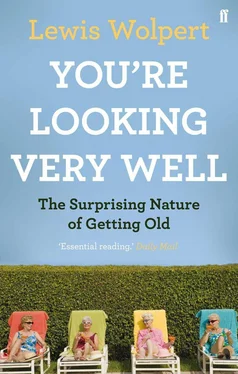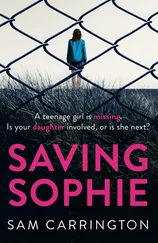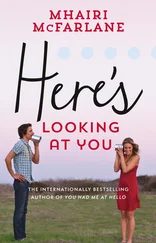* * *
Ageing is best understood as the result of accumulation of random molecular damage in cells for a variety of causes—essentially errors due to wear and tear, and the mechanisms that cause this, and that involve damage to genes and proteins which the cells are unable to reliably repair, will be discussed next. These chance events occur in all body cells, and there are some mechanisms to repair the damage. An exception to such damage is in the germ cells that give rise to the next generation. Germ cells dare not suffer age-related damage, as if they did there would soon be no future healthy offspring. Evolution knows this and ensures that they do not age. By contrast, body cells do age, and evolution only cares to limit this so that reproduction can occur. Evolution selects those cellular activities that delay ageing until reproduction is completed.
Explaining ageing in these terms is partly based on an idea of Weismann, who dropped his theory that ageing was adaptive, and then suggested that ageing evolved because organisms separate in their body those organs involved in reproduction, particularly those that give rise to germ cells—eggs and sperm—from the rest of the body. They invest heavily in those organs involved in reproduction, and this neglect of the body results in ageing. Support for this is found in model organisms, where fertility and lifespan are closely linked. In the nematode C. elegans , cutting out of germline precursor cells of the gonad abolishes reproduction but extends lifespan, as do mutations that reduce germline proliferation. In the fruit-fly D. melanogaster , a reduction in reproduction extends lifespan in females, and certain long-lived mutant females exhibit reduced egg laying, with some being almost sterile. Certain mice that have mutations causing dwarfism are long-lived and sterile.
Researchers have also found that ageing and lifespan do evolve in subsequent generations of biological species in a theoretically predicted direction, depending on particular living conditions. For example, selection for later reproduction—artificial selection of late-born progeny for further breeding—produced, as expected, longer-lived fruit flies, while placing animals in a more dangerous environment with high extrinsic mortality redirected evolution, as predicted, to a shorter lifespan in subsequent generations. Selection of eggs from older flies progressively led to much older flies which lived twice as long.
This all fits with Thomas Kirkwood’s disposable soma theory, where soma refers to the body. The power of selection fades with age. The disposable soma theory argued that ‘it may be selectively advantageous for higher organisms to adopt an energy saving strategy of reduced accuracy in somatic cells to accelerate development and reproduction, but the consequence will be eventual deterioration and death’. Given finite resources, the more the body spends on maintenance of the body, the less it can spend on reproduction. Molecular proofreading is reduced and so are other accuracy-promoting devices in body cells. Energy must be devoted to germ cell reliability but damage can accumulate in body cells—there are so few germ cells by comparison. From the point of view of evolution, the prevention of ageing is only necessary until the animals have reproduced and cared for the young sufficiently well; nature has therefore provided repair measures to delay the process until that is done. According to this theory, we and other animals are disposable once reproduction and the rearing of children have been completed.
Pacific salmon of both sexes do not care for the young and they die a few weeks after spawning. The male marsupial mouse dies after intense spawning from immune system collapse, but not the female. There are also animals that live well past their reproductive period—including whales and human females. In both cases this is due to their looking after and nursing the young, their own as well as those of others in the case of whales.
There is overwhelming evidence that there are strong genetic influences on the rate of ageing. Perhaps the most compelling evidence is that the differences of rates of ageing within individuals of a species are negligible compared with the vast differences across species. Honeybee workers live only a few weeks compared to the queen, who lives for years because she was fed honey when a larva. A mayfly moults, reproduces and dies within a single day, in some cases with a functional lifespan measured in hours; by contrast, giant tortoises can live for over 150 years, helped probably by their protective armour. The powerful influence of genetics is further reflected by the ever increasing number of single-gene mutations that can influence the lifespan of organisms ranging from yeast to mice.
An important example is that of female reproduction changing with getting older. This, due to menopause, is unlike ageing, and is programmed by our genes. Women can reproduce over long periods. The oldest mother is from India—she had twins at 70 with IVF. In the UK the oldest is 66. It is argued that 63 should be the maximum age, as the child needs a mother for some 20 years, which takes her to 83. A girl became the UK’s youngest mother at the age of 12.
This raises the question of why there is a menopause in women and thus an end to reproduction. The average age in Britain for the menopause to occur is 51 years old. Why do women forgo years of their reproductive lives? What selection pressures could result in this unique human adaptation? Menopause may be explained by the ‘good mother’ theory—energy should be devoted to looking after children rather than having more. It may have been that, since childbirth is risky in humans, menopause allowed older women to survive longer and better raise their existing children. Another possibility is commonly known as the ‘grandmother’ hypothesis, and argues that women who stopped ovulating in their golden years were freed from the costs of reproduction and were better able to invest in their existing children and grandchildren, thus helping to ensure that more individuals with their menopause-inducing genes thrived and had children themselves.
A remarkably complete and instructive data set from Gambia offers a window into a world without the benefits of modern health care. What the data reveals is that children were significantly more likely to survive to adulthood if they had a grandmother’s assistance. Grandmothers from Gambia are crucial to infant survival. In other studies data revealed that a child was over 10 times less likely to survive if its mother died before it was two years old, but that children between one and two had twice the chance of surviving if their maternal grandmother was still alive. No other relatives had any effect. But while menopause may result in less cancer, it increases the risk of heart disease and osteoporosis.
‘From age to age, nothing changes, and yet everything is completely different’
— Aldous Huxley
If ageing is not programmed by our genes, then why and how do we age? The answer lies in our cells. We are essentially a society of billions of cells. Cells, for their size, are the most complex structures in the universe. It is proteins that determine how cells behave; genes only provide the essential code for making proteins. A typical cell, like one in our skin, will contain thousands of different proteins, and millions of copies of some of them. Complex interactions between the proteins and the genes determine which proteins will be synthesised and so determine how the cell behaves.
Proteins are long strings of quite small units, amino acids, whose sequence is coded for by the DNA of the genes, and this sequence determines how proteins will fold and then function. We age because of wear and tear, in a way not dissimilar to that of any machine, for example a car; death rates for cars follow a similar pattern to those for animals. There is no single ageing process. Ageing results from an accumulation of cellular damage and the limitations in the cells’ ability to repair the damage, particularly in our DNA and proteins, and so restore normal function to the cell. The maintenance of the integrity of DNA is a challenge to every cell, for such damage leads to the absence of key proteins, the synthesis of proteins in the wrong cells at the wrong time, and also to proteins with bad properties. Such damage accumulates randomly throughout life, from the time when body cells and tissue first begin to form. It is striking how organisms with the same genes, like identical twins, can age quite differently because of the random nature of the causes of the damage. Chance events are an integral part of ageing.
Читать дальше












